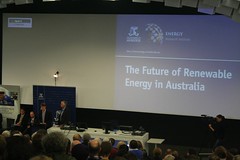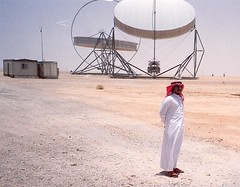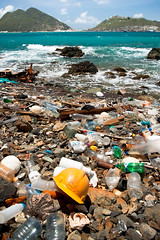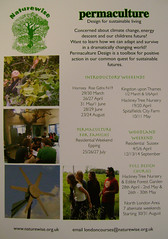 Image by Augustin Rouchon via Flickr
Image by Augustin Rouchon via FlickrBy
Kamal Kishore Srivastava
It was a clear and crisp morning at Corbett National Park - one of the most vivid and rich national parks of India well known for its tigers. After a previous day's torrential rain, the climate had become very pleasant and the animals were out on their feeding spree. Riding on elephant-back, crossing the perennial Ramganga River, which traverses the park, a feeling of awe and excitement engulfed me.
Suddenly all things in the area seemed petrified. The atmosphere became charged - the herds of spotted deer started giving alarming calls. The
mahout of the elephant cautioned in a low whisper. The jungle king was on the prowl. Lo! A big tiger was sighted, barely a few feet away. The magnificent and majestic beast, whose angry growl is enough to make anyone freeze was right in front of us, making a gesture to charge. He did, but failed and then sat for quite some time, growling and whipping its tail. We observed nature's marvel with admiration...
These majestic animals are now fighting desperately for their survival. Their number is declining fast. Paradoxically, they are the most talked about but equally are in most danger.
Long ago tigers roared from eastern Turkey to the Russian Far East up to Siberia and into Bali. With the passage of time the Balinese, Javanese and Caspian tigers became extinct. Their number is fast declining in India too and the days are not far off when they might be wiped out forever. The coming generation might see them in textbook drawings and photographs only.
The main culprit - illicit killing, has brought the number of tigers from 3455 in 1997 to 1411 at present. A recently released tiger census report by National Tiger Conservation Authority states the numbers of tigers in India ranges from 1165 to 1657 (an average of 1411). According to the Wildlife Protection Society of India (WPSI), in the year 2009 thirty two tigers lost their lives in favor of the greed and lust of the poachers. Despite that the tiger
(Panthera tigris) is a protected animal by law and killing this animal attracts fines and imprisonment under the provisions of
The Wildlife (protection) Act, 1975 such reports indicate the rampant killing.
The growing demand for tiger parts in manufacturing the so-called valor medicines, and their skin hides have significantly contributed to the poaching of tigers. A huge amount of money every year is involved in the illegal trade of wild-life products. Though the exact amount of money involved in the illicit trade of tiger parts is not possible to obtain, the amount of confiscation, seizures and arrests of poachers are indicative of the magnitude. India is still the residence of these magnificent animals, ironically, for tiger parts most of the demand comes from outside the country. Tigers are generally poached by the local tribes either by poisoning, iron trapping or electrocuting them. These tribes are lured by the greedy middlemen.
India has witnessed a population explosion. To provide a better future to the citizens, various developmental projects started. The need for establishing heavy industry, hydro-electric power plants and housing colonies requires land. This has put tremendous pressure on the natural wealth including forests, lakes, rivers and grasslands. More and more land is required for tilling and housing to fulfill the needs of the ever-increasing human population.
Agricultural land and villages in the vicinity of cities are being used for housing purposes whereas more and more grasslands, forests and woodlands are being cleared for agricultural purposes. The shrinking forest cover, thus, has forced wild animals to come out into the open, creating man-animal conflicts for obvious reasons. This has made the poaching even more easy - done under the disguise of saving life, livestock and property of humans.
The
terai belt of
Uttar Pradesh, previously well known for its rice production, has witnessed a major shift in their crop growing pattern. The establishment of sugar mills and the promotion for more sugarcane production to fulfill the needs of these mills has contributed significantly to this cropping shift. Large forest areas have been surreptitiously cleared and encroached upon in order to sow cash crops like sugarcane. The shrinkage of the natural habitat has pushed wild herbivores - a staple food of the tiger, towards the fringe areas and to these sugarcane fields. These in turn, pull the tigers out of the jungle.
Unable to differentiate between grasslands and sugarcane fields they thus enter the sugarcane fields. Finding these cane fields safe, they stay there. These so-called
"Cane-tigers" become a threat to the lives, property and the livestock of the villagers. These tigers, finding them their easy prey, often kill domestic animals or sometimes even humans, and cause panic. Such animals are surely a danger to the people living in the vicinity of these areas. The result is that many tigers have been poisoned by villagers (read poachers). Many tiger deaths have been reported thus.
The decline in the number of tigers has a genetic fall out as well, and in turn is harmful to them. Fast declining populations give rise to small and isolated populations making them prone to natural disasters. Conflagrations, hurricanes and epidemics may cause them to give up the ghost
en mass. Moreover, they give rise to fewer potential breeding populations in a given tiger population and to an even lesser number of potential breeding individuals. This results in excessive inbreeding which has its own ill effects. The lethal gene, if present, is recessive - not manifesting; can become potentially dangerous. This 'forced inbreeding' can cause havoc to the population.
Alarmed and concerned by the fast declining tiger population in the country the Government of India headed by the then Prime-minister, the late Mrs. Indira Gandhi, launched Project Tiger in April 1973. The objective of the project was "to ensure maintenance of a viable population of Tigers in India for scientific, economic, aesthetic, cultural and ecological values, and to preserve for all time, areas of biological importance as a national heritage for the benefit, education and enjoyment of the people". Since its inception 28 tiger reserves in seventeen states have been created. This helped substantially in evoking a positive public response.
The woodlands, wetlands, forests, grasslands and the animals inhabiting them are the linchpin of the ecosystem. Above and beyond adding aura, color and drama; being at the top of the food chain, tigers contribute appreciably in maintaining harmony and ecological balance. They are the national heritage.
However, there was a time when these magnificent wild beasts, especially the big cats were killed heartlessly in the name of game hunting. The well-known naturalist and hunter Jim Corbett, who shot many man-eaters and after whom one of the famous wildlife parks of India has been named (Corbett National Park), later hung up his gun in favor of these creatures. The shooting of tigers and other wild animals with a camera - not with a gun is far more rewarding. Indeed, a trophy enchants only a select few who possess them but a good photograph enchants and educates many people. This, not only saves these wonderful animals, but the heritage and eco-balance too and in turn, planet earth as well.
I am a solitary type of person who takes time to open up. Though a bit conservative in making friends, I like the company of like minded and sensible people who think positively. I have a deep reverence for Mother Nature and prefer to live in her vicinity which gives me solace and energy for my thought processes to trigger.
I like visiting important natural and heritage places, no matter how small are they. Reading serious literature pertaining to the environment, ecology and life sciences and photography are also my likes. Happenings around influence me and agitate my mind. Meticulous and orderly things attract me. The social order ought to be clear from all ill things - this is what I think and wish. I write and share my views with people. I want to be heard. Writing articles is, I feel, a good medium for self expression.
Article Source:
http://EzineArticles.com/?expert=Kamal_Kishore_Srivastava
http://EzineArticles.com/?Diminishing-Tiger-Population---A-Cause-of-Concern&id=4839715
 Image by net_efekt via FlickrBy Will McCorkle
Image by net_efekt via FlickrBy Will McCorkle



































